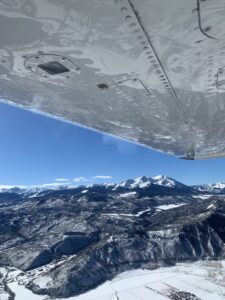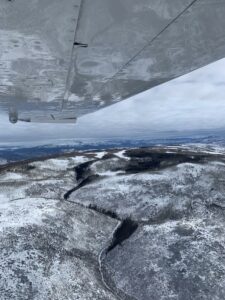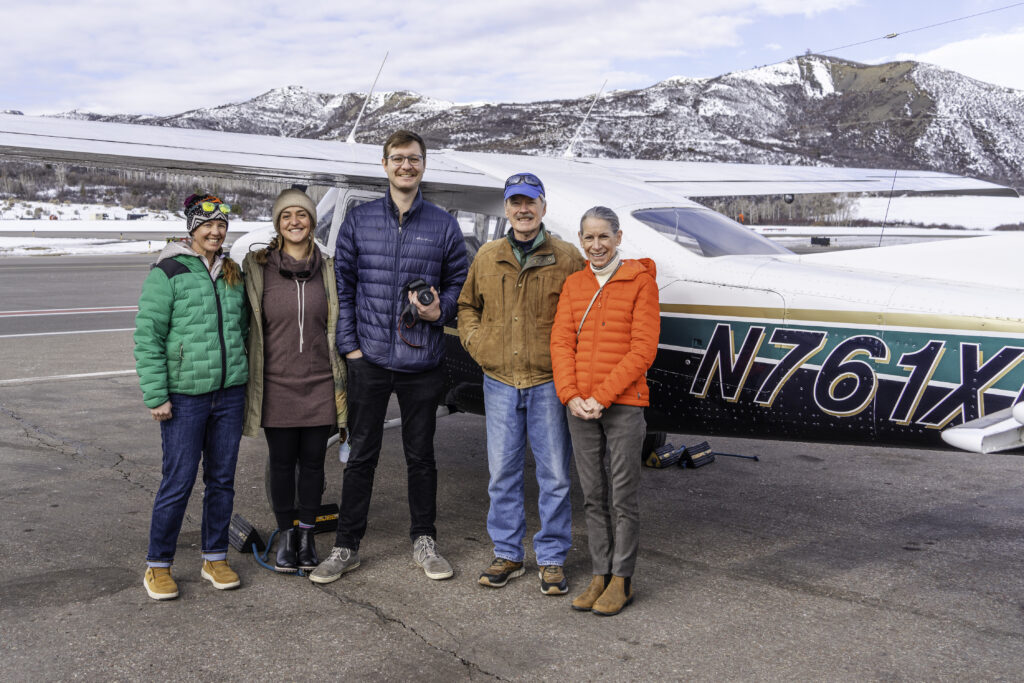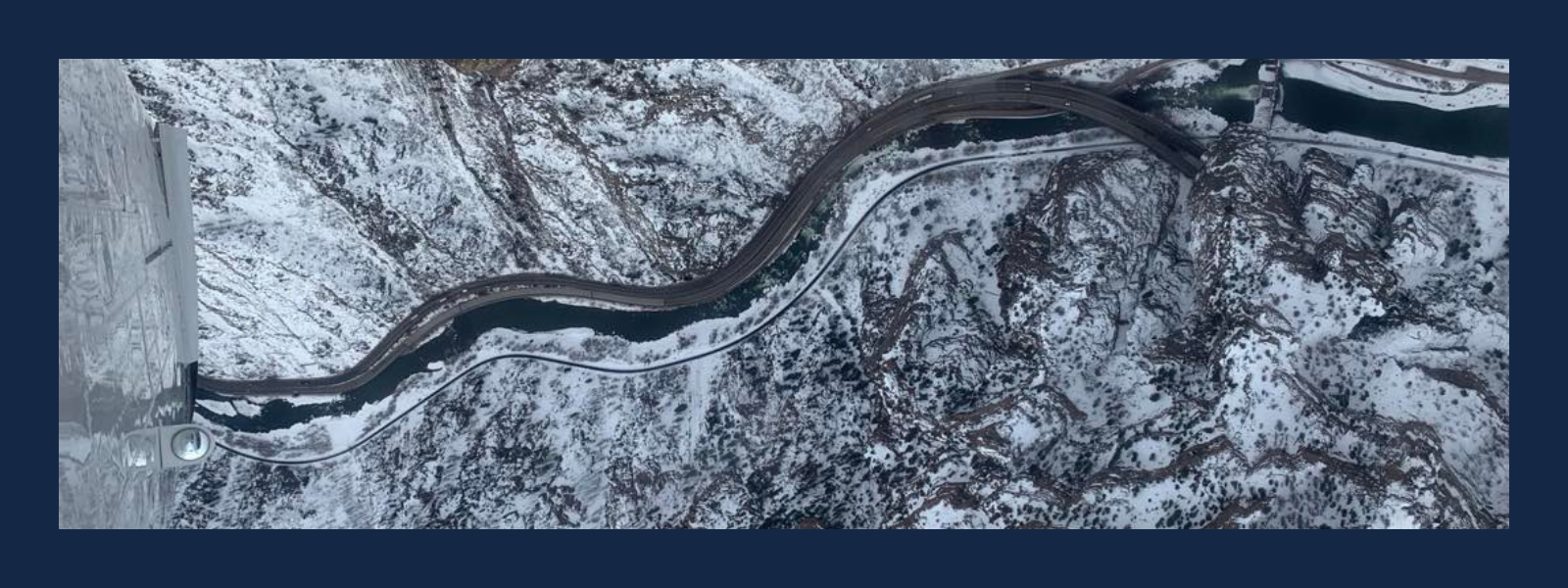
When Alex Hager, a KUNC reporter covering the Colorado River basin, asks if you want to go for a ride with EcoFlight, you don’t pass up the opportunity. My chance arose earlier this year when Alex was capturing photos for a piece he was working on regarding the sale of the water rights for the Shoshone Power Plant in Glenwood Canyon to the Colorado River Water Conservation District (check out his story here!). The purchase of these water rights, if funding is secured, will keep the water in the river in perpetuity, ensuring ecological flows for a wide diversity of species, some endangered, whose survival is dependent on a healthy and well-conserved river. EcoFlight is a non-profit dedicated to educating and advocating for the protection of wild places through the use of small aircraft, and opening people’s eyes to landscapes and the importance of goals such as 30×30.
On top of learning about this incredible initiative, I used the opportunity to get into that tiny plane and reflect on a place that is near and dear to my heart, the Roaring Fork Valley of Colorado. I have spent the last 6 years living and recreating here, and though I have flown above what locals refer to as “the valley” in large commercial planes, never had I gotten to see this home from this wild perspective.
Two things stuck out to me as we were in flight:
- How lucky and privileged I am to live in a place with huge swaths of land conserved publicly and privately, because of countless individuals, organizations, and partnerships committed to protecting the landscapes.
- How deeply connected the Roaring Fork Valley is to the greater Colorado river system that supplies water for some 35 million people across the West.
Birds-eye view
I would like to acknowledge that the Roaring Fork Valley is the traditional homelands of the Ute Indian People, who were forcefully removed in the 1800’s following the rapid colonization of the area due to the abundance of minerals such as silver.

The Roaring Fork Valley of Colorado is an approximately 70-mile and 928,640 acre landscape that begins west of the Continental divide of Independence Pass, and proceeds to flow through Aspen, Basalt, Carbondale, and Glenwood Springs, before joining the mighty Colorado river flowing west across the United States and into Mexico. According to a study done by the Colorado Natural Heritage Program in 2022, the area is “one of the most ecologically intact and varied landscapes in Colorado.” Our flight began at the Aspen airport and flew us down the valley to eventually circle the Colorado river flowing through Glenwood Canyon. Though this is one of the most rapidly growing areas in Colorado, it was remarkable to witness the vast swaths of public land that surround the valley, providing critical habitat for wildlife, recreation opportunities for residents and visitors alike, and vital ecosystem services.
As a region that is defined by its abundance of outdoor recreation opportunities, and a long history of ranching and land stewardship, the local populace is exemplary in their passion for conserving these landscapes. One of my favorite stories is of the “Maroon Belles,” a trio of women who came together in the 1960s to advocate for conservation, and eventually “influenced or were directly responsible for 500,000 acres of wilderness designation in or around the Roaring Fork Valley.” Today, there are a plethora of organizations working to conserve biodiversity and build climate resilience for the region, some of my favorites include the Roaring Fork Conservancy, the Roaring Fork Valley Wildfire Collaborative, Watershed Biodiversity Initative, Wilderness Workshop, Aspen Valley Land Trust, the Aspen Center for Environmental Studies, and many more. Though the Roaring Fork Valley faces challenges ranging from high socio-economic inequalities, the historical exclusion of the Ute tribe from the region, climate change, invasive species, and rapid development, I am optimistic that these landscapes will be around for years to come, thanks to the tireless efforts of organizations and residents to protect them.
Part of something greater
It was impossible to sit in the plane and not think about how each bit of snow that falls throughout the winter has the potential to end up 1,450 miles away in Mexico, once the Roaring Fork River joins the Colorado River. It can be tempting to solely focus on local environmental effects and challenges but remembering that the Roaring Fork Valley is part of a larger system stressed the importance of maintaining these landscapes for the wellbeing of humans and ecosystems across the West.
One of the programs I work on at the Salazar Center is the Peregrine Accelerator for Conservation Impact, a funding and capacity building program designed to advance new conservation solutions in priority ecoregions across North America. The goal of focusing the program in a defined and connected region is to build cohesion among a cohort of practitioners working together to protect a similar resource, despite being separated by large distances. For the pilot year of this program, we focused our efforts on the Rio Grande-Rio Bravo basin, an 1,885-mile river that begins in the San Luis Valley of Colorado, flows through two more U.S. States, and into Mexico before ending in the Gulf of Mexico.
The impact of each tributary and landscape on the Rio Grande-Rio Bravo system is profound, highlighting the need for landscape level conservation from headwaters to delta. The same is true of the Colorado river basin, as we have witnessed in recent years as the impacts of climate change, landscape change, and overallocation of water has caused intense stress on water resources across the watershed.
Intact ecosystems are critical for maintaining our water resources, and as the West experiences warmer temperatures and a reduced snowpack, it is ever more critical that conservation of nature is prioritized to ensure we have secure water resources into the future. Mountain communities like the Roaring Fork Valley are undergoing population increases and development pressure at unprecedented rates. As we balance the need for meeting housing and infrastructure needs with conserving our natural resources, maintaining the vision that we are part of something much bigger than our valley can be a driver for preserving intact landscapes.
The opportunity to see a place I love from this perspective was profound and impactful. The next time I hike in the Elk Mountain range, or recreate on the Roaring Fork river, I will remember what it looked like from above, and that every step I take, every initiative I vote for, and every one of my choices regarding this land is connected to something bigger than me, and for that I am grateful. Thank you to Gary from EcoFlight and Alex Hager for the opportunity to connect with the place I call home from above!


